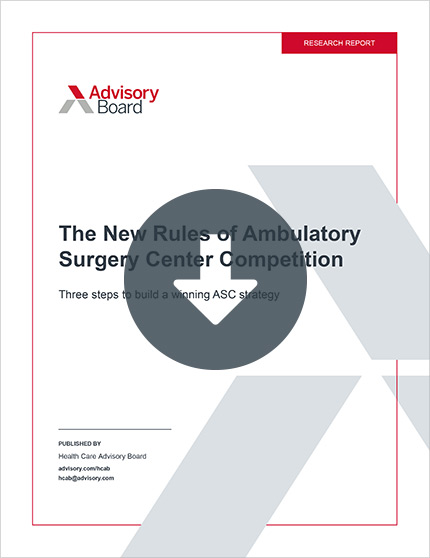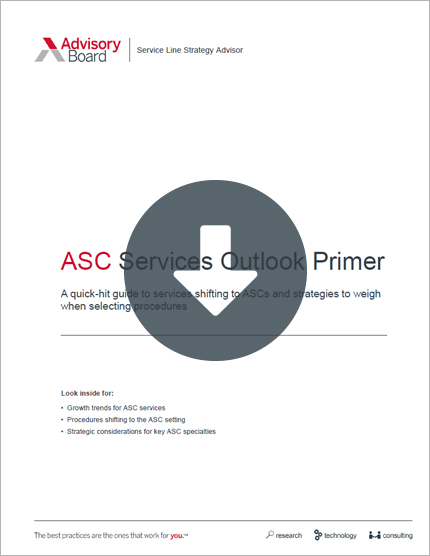Auto logout in seconds.
Continue LogoutEditor's note: This popular story from the Daily Briefing's archives was republished on June 10, 2019.
By Jackie Kimmell, Senior Analyst
Outmigration isn't a new concern for hospital leaders. But while leaders once worried about the shift of surgeries from high-revenue inpatient settings to lower revenue hospital outpatient (HOPD) settings, the rapid growth of ambulatory surgical centers (ASCs) is stoking even greater fears about the ability to maintain hospital surgical revenues.
Webconference recording: 3 steps to building a winning ASC strategy
That shift threatens to take surgeries one step further from hospitals—to even lower-cost ASCs. And it's happening quickly. If you look at the total number of outpatient surgeries in 2005, you saw roughly a 60-40 split (that is, 59% of outpatient surgeries were performed in HOPDs compared with 41% in ASCs). By 2020, projections show this will have flipped; only 40% of surgeries will be performed in HOPDs.
This reversal is clearly reflected in total ASC volume growth. In 2017, ASC volumes increased by 22.9% nationally. In 20 of the top 50 largest U.S. markets, ASCs more than doubled their market share between 2015 and 2016. And looking ahead, the U.S. ASC market is expected to surpass $40 billion by 2020.
What's behind this rapid rise of ASCs? Read on to learn how each industry stakeholder is pushing the market to grow.
Why are ASCs growing so quickly? 3 leading factors
Most of the previous shift from inpatient to outpatient settings was driven by advances in technology and technique which made it possible to perform previously intensive surgeries in a less-invasive manner, shortening recovery time and reducing infrastructure requirements.
Yet, today's outmigration is fundamentally different because it's principally driven by purchasers. Here's how payers, consumers, and physicians have contributed to the latest shift.
- Payers, specifically Medicare, have adopted new tactics to relocate patients
Given the lower cost to payers for common surgeries in ASCs (for example, an average pacemaker implant is reimbursed by Medicare at $3,721 in an ASC, compared with $7,731 in an HOPD and $14,540 in an inpatient setting), payers have aggressively pushed to relocate patients to these alternate sites.
CMS has been particularly aggressive recently, such as by pushing site-neutral payments to compress HOPD rates while also modifying payment rate increases to make ASCs more attractive. They've also expanded the list of procedures eligible to be added to the ASC covered list, most notably adding 12 cardiac catheterization procedures, and suggesting adding total and partial hip replacements as well.
Private payers have followed CMS' lead by adjusting contracts to lower HOPD reimbursement and requiring hospitals to perform a certain percentage of outpatient cases in ASCs in order to receive reimbursement increases over time. Others have used preauthorization requirements as a lever, letting PCPs refer directly to ASCs while requiring preauthorization for HOPD procedures. Finally, some payers have directly altered patient benefit design to incentivize ASC choice. For instance, UnitedHealthcare*, Aetna, and Medicare offer patients lower copays for procedures performed in ASCs than in HOPDs.
*Editor's note: Daily Briefing is published by Advisory Board, a division of Optum, which is a wholly owned subsidiary of UnitedHealth Group. UnitedHealth Group separately owns UnitedHealthcare.
- Consumers continue to flock to cheaper prices, better experience
Consumers, for their part, have been happy to oblige with these reduced copays and lower prices. It's important not to underestimate how much price matters to surgical patients. In one Advisory Board survey, surgical patients reported that the cost of surgery impacted their choice of where to seek care more than travel time, recommendations, hospital affiliation, location of follow-up visit and the quality of the surgeon combined. Not to mention, ASCs often have many of the experience factors—like easy scheduling, greater appointment availability, minimal wait times, and convenient parking—that make them attractive to consumers.
- Physicians see the potential for extra income
There are many factors encouraging physicians to shift surgical cases to ASCs. Many ASCs have—and continue to—advertise appealing equity options to physicians. In 2017, 92% of ASCs included physicians as equity owners, and many offer physicians the ability to gain additional revenue from ancillary services. But even for physicians without a financial stake in ASCs, the centers can be appealing. Payers often offer higher physician payment rates in ASCs, and some provide cash bonuses on a per case basis for every appropriate patient that receives care in an ASC as opposed to a HOPD. Finally, ASCs tend to have higher throughput and be more efficient, which can allow physicians the ability to perform a higher volume of surgeries. As more high-revenue procedures get approved for ASCs, operating in ASCs will likely become even more attractive for physicians.
How can providers best respond?
Hospitals and health system leaders have three strategic options for how to proceed in the growing but competitive ASC market. First, they can attempt to reverse the outpatient shift by engaging in protectionist tactics intended to keep cases in the inpatient setting and convert ASCs to hospital-based reimbursement rates. In the long term, however, this approach is likely ineffective with consumers and payers.
Second, health systems could overlook the outpatient setting altogether by prioritizing the inpatient business and not actively undermining outmigration or investing in ASCs. Given the relatively lower growth of inpatient care and higher growth of outpatient procedures, organizations will struggle to meet revenue goals without capturing outpatient growth.
Third, leaders can implement a proactive strategy to compete for outmigrating cases. Fortunately, the shift to outpatient surgery is unleashing latent demand, and by competing effectively, hospitals and health systems can capture a portion of this growing and lucrative market. As a result, this is the most appealing path forward for hospital and health system leaders, at least in the long term.
Want to learn more about how you can build a winning ASC strategy? Download an excerpt of report on The New Rules of Ambulatory Surgery Competition.
Webconference recording: Follow these 3 steps to build a winning ASC strategy
Watch this webconference recording to find out how you can implement a winning ASC strategy and compete against new and traditional competitors alike.
Don't miss out on the latest Advisory Board insights
Create your free account to access 1 resource, including the latest research and webinars.
Want access without creating an account?
You have 1 free members-only resource remaining this month.
1 free members-only resources remaining
1 free members-only resources remaining
You've reached your limit of free insights
Become a member to access all of Advisory Board's resources, events, and experts
Never miss out on the latest innovative health care content tailored to you.
Benefits include:
You've reached your limit of free insights
Become a member to access all of Advisory Board's resources, events, and experts
Never miss out on the latest innovative health care content tailored to you.
Benefits include:
This content is available through your Curated Research partnership with Advisory Board. Click on ‘view this resource’ to read the full piece
Email ask@advisory.com to learn more
Click on ‘Become a Member’ to learn about the benefits of a Full-Access partnership with Advisory Board
Never miss out on the latest innovative health care content tailored to you.
Benefits Include:
This is for members only. Learn more.
Click on ‘Become a Member’ to learn about the benefits of a Full-Access partnership with Advisory Board
Never miss out on the latest innovative health care content tailored to you.


